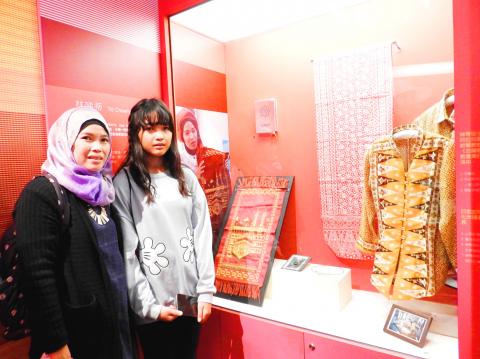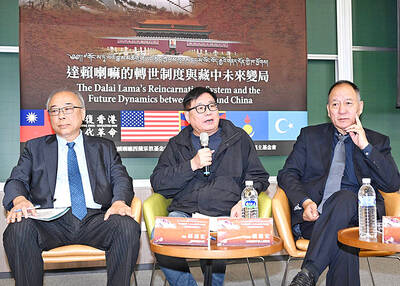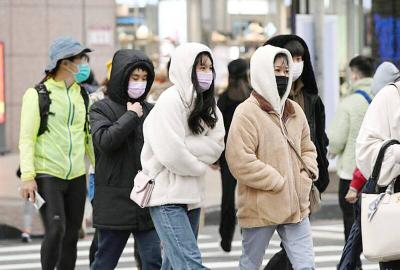A new exhibition at the National Museum of Taiwan History, “Southeast Asian Immigrants and Migrant Workers in Taiwan,” explores the lives of these people through personal artifacts and creative works.
Personal items from three families and 14 workers were collected by curators at the Tainan museum, who said they are hoping to show the new face of Taiwan through individual stories.
The exhibition opened on Saturday last week with a performance by women from the Philippines, Vietnam and Indonesia who sang a “eulogy to sisters” to the melody of a Thai folk song.

Photo: Hung Jui-chin, Taipei Times
The song expresses the challenges the women face in migrating to a new place far from their homes, and the difficulties of leaving family members who cannot stay with them in Taiwan because of the nation’s immigration laws.
Museum Director Margaret Wang (王長華) said Taiwan is home to more than 140,000 Southeast Asian immigrants and 680,000 migrant workers, and Southeast Asians have long been an important part of the nation’s culture.
The exhibition explores 50 years of immigration from Southeast Asia, telling individual stories through video clips, sound recordings and creative works, Wang said, adding that she hopes it will inform others about the immigrant and migrant worker communities.
One section focuses on the rapid growth in the number of immigrants starting in the 1990s, Wang said, adding that it reflects on challenges that emerged due to immigration regulations and questions related to human rights and social justice.
Social groups such as the TransAsia Sisters Association, Taiwan and the 4 Way Voice media outlet have been active in leading discussions on these issues, Wang said.
The exhibition runs through Nov. 5. More information about the show can be found on the museum’s Web site in Chinese, English and Japanese.

ALIGNED THINKING: Taiwan and Japan have a mutual interest in trade, culture and engineering, and can work together for stability, Cho Jung-tai said Taiwan and Japan are two like-minded countries willing to work together to form a “safety barrier” in the Indo-Pacific region, Premier Cho Jung-tai (卓榮泰) yesterday said at the opening ceremony of the 35th Taiwan-Japan Modern Engineering and Technology Symposium in Taipei. Taiwan and Japan are close geographically and closer emotionally, he added. Citing the overflowing of a barrier lake in the Mataian River (馬太鞍溪) in September, Cho said the submersible water level sensors given by Japan during the disaster helped Taiwan monitor the lake’s water levels more accurately. Japan also provided a lot of vaccines early in the outbreak of the COVID-19 pandemic,

Kaohsiung Mayor Chen Chi-mai (陳其邁) on Monday announced light shows and themed traffic lights to welcome fans of South Korean pop group Twice to the port city. The group is to play Kaohsiung on Saturday as part of its “This Is For” world tour. It would be the group’s first performance in Taiwan since its debut 10 years ago. The all-female group consists of five South Koreans, three Japanese and Tainan’s Chou Tzu-yu (周子瑜), the first Taiwan-born and raised member of a South Korean girl group. To promote the group’s arrival, the city has been holding a series of events, including a pop-up

TEMPORAL/SPIRITUAL: Beijing’s claim that the next Buddhist leader must come from China is a heavy-handed political maneuver that will fall flat-faced, experts said China’s requirement that the Dalai Lama’s reincarnation to be born in China and approved by Beijing has drawn criticism, with experts at a forum in Taipei yesterday saying that if Beijing were to put forth its own Dalai Lama, the person would not be recognized by the Tibetan Buddhist community. The experts made a remarks at the two-day forum hosted by the Tibet Religious Foundation of His Holiness the Dalai Lama titled: “The Snow Land Forum: Finding Common Ground on Tibet.” China says it has the right to determine the Dalai Lama’s reincarnation, as it claims sovereignty over Tibet since ancient times,

Temperatures in some parts of Taiwan are expected to fall sharply to lows of 15°C later this week as seasonal northeasterly winds strengthen, the Central Weather Administration (CWA) said today. It is to be the strongest cold wave to affect northern Taiwan this autumn, while Chiayi County in the southwest and some parts of central Taiwan are likely to also see lower temperatures due to radiational cooling, which occurs under conditions of clear skies, light winds and dry weather, the CWA said. Across Taiwan, temperatures are to fall gradually this week, dropping to 15°C to 16°C in the early hours of Wednesday